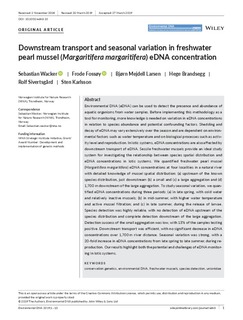| dc.description.abstract | Environmental DNA (eDNA) can be used to detect the presence and abundance of aquatic organisms from water samples. Before implementing this methodology as a tool for monitoring, more knowledge is needed on variation in eDNA concentrations in relation to species abundance and potential confounding factors. Shedding and decay of eDNA may vary extensively over the season and are dependent on environmental factors such as water temperature and on biological processes such as Activity level and reproduction. In lotic systems, eDNA concentrations are also affected by downstream transport of eDNA. Sessile freshwater mussels provide an ideal study system for investigating the relationship between species spatial distribution and eDNA concentrations in lotic systems. We quantified freshwater pearl mussel (Margaritifera margaritifera) eDNA concentrations at four localities in a natural river with detailed knowledge of mussel spatial distribution: (a) upstream of the known species distribution, just downstream (b) a small and (c) a large aggregation and (d) 1,700 m downstream of the large aggregation. To study seasonal variation, we quantified eDNA concentrations during three periods: (a) in late spring, with cold water and relatively inactive mussels; (b) in mid‐summer, with higher water temperature and active mussel filtration; and (c) in late summer, during the release of larvae. Species detection was highly reliable, with no detection of eDNA upstream of the species distribution and complete detection downstream of the large aggregation. Detection success of the small aggregation was low, with 13% of the samples testing positive. Downstream transport was efficient, with no significant decrease in eDNA concentrations over 1,700 m river distance. Seasonal variation was strong, with a 20‐fold increase in eDNA concentrations from late spring to late summer, during reproduction. Our results highlight both the potential and challenges of eDNA monitoring in lotic systems. | nb_NO |

